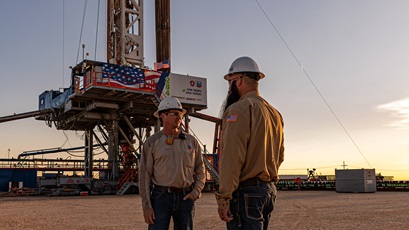people and community
low-code drives high output for chevron’s citizen developers
2 min read | august 17, 2023
When Andrew Shing faced a problem with no good solutions, he used his Citizen Developer training as a low-code developer to create one and improve processes to drive better business outcomes.
As senior planner in Chevron’s El Segundo Oils Planning team, Shing worked with colleagues who received dozens of certificates of analysis from labs each month. He knew that organizing the data was possible but would be difficult since the data was in PDF documents with no standard format. He wanted a way to locate and share the data so it would be easier to analyze and to get to the heart of any issues.



the big lift of low-code
Chevron’s progress in low-code developments is a result of the company being one of the first to embrace the Microsoft Power Platform® at enterprise scale.
Now, nearly 3,000 employees in departments across Chevron use low-code and can create apps or automated tasks to improve their daily work and drive business decisions.
nicole champenoy
shale and tight asset class director
why it matters
Shing estimates he invested 150 to 200 hours in low-code development training over three months to get up to speed. His app will save up to double that amount of time annually. Plus, the experience prepared Shing to apply low-code techniques to other time-consuming issues that are hard to solve.
“There are pieces that I’ve taken from that program that I have applied to other parts of the business to help find efficiencies,” said Shing. “Having confidence that all our data sources are pulling from the same location helps create alignment much more quickly.”
what’s next
“Low-code is the next version of office work,” explained Tavia Prouhet, a low-code and automation product owner for Chevron. “Every worker can learn how to do this whether you’re a new employee or someone more established.”
In fact, Gartner, the U.S.-based research and consulting firm, expects the market for low-code development to grow 20% this year due to citizen developers who sit outside of IT, like Shing. That group made up 60% of low-code users in 2021 and will grow to 80% by 2026.
20%
expected low-code development growth in 2023
60%
citizen developers as low-code users in 2021
80%
expected citizen developer low-code user growth
Power Platform is a federally registered trademark of the Microsoft group of companies.
topics covered
related content
-

 supporting STEM education in new mexico
supporting STEM education in new mexicopeople and communitynovember 18, 2025
-

 frontline innovations drive business solutions
frontline innovations drive business solutionspeople and communitynovember 12, 2025
-

 the people who power the US energy advantage
the people who power the US energy advantageour operationsnovember 06, 2025
-

 greeley stampede is riding high, with chevron’s support
greeley stampede is riding high, with chevron’s supportpeople and communityaugust 18, 2025
chevron email updates
Subscribe to our newsletter to receive news and updates.



